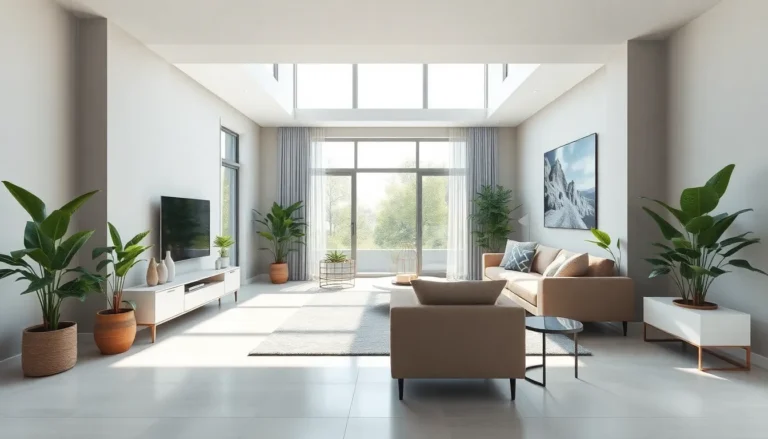Table of Contents
ToggleInterior design sketches are like the secret sauce of the design world. They’re the playful doodles that transform wild ideas into stunning spaces. Ever tried to explain your vision for a cozy reading nook without a sketch? It’s like trying to describe a cat to a dog—confusing and a little chaotic!
These sketches not only capture the essence of creativity but also serve as a roadmap for turning dreams into reality. Whether you’re a seasoned designer or a DIY enthusiast, mastering the art of sketching can elevate your projects from drab to fab. So grab those pencils and let’s dive into the whimsical world of interior design sketches—where imagination meets practicality and every line tells a story.
Overview of Interior Design Sketches
Interior design sketches serve as essential tools for transforming ideas into visual representations. These sketches facilitate communication between designers and clients, making it easier to convey design concepts.
Importance of Sketches in Design Process
Sketches play a pivotal role in the interior design process. They help clarify ideas, allowing designers to explore different options rapidly. Creative insights emerge during sketching, leading to unexpected and innovative solutions. This visual method can identify potential design challenges early. Fast iterations enable designers to adapt concepts without significant time loss. Furthermore, sketches foster collaboration among team members and clients, enhancing the overall design experience.
Types of Interior Design Sketches
Various sketch types cater to different phases of the interior design process. Concept sketches provide an initial visualization of ideas. Floor plans detail the layout, including dimensions and placements of furniture. Elevation sketches showcase vertical elements, highlighting wall details and finishes. 3D perspectives offer realistic views, enabling a better understanding of space and design. Renderings elevate sketches with color and texture, making visions more tangible. Each sketch type serves a unique purpose, enhancing the project’s development from inception to completion.
Techniques for Creating Effective Sketches

Creating effective interior design sketches involves various techniques that enhance communication and visualization. These techniques cater to both hand-drawn and digital formats, each offering unique advantages.
Hand-Drawn vs. Digital Sketches
Hand-drawn sketches provide a personal touch, allowing designers to express creativity freely. These sketches can easily be modified on the fly, making them useful for brainstorming sessions. Digital sketches, on the other hand, offer precision and the ability to incorporate various design tools. They enable designers to experiment with colors, textures, and layers quickly. While hand-drawn sketches might capture spontaneity, digital versions often allow for cleaner, more polished presentations. Designers choose based on their style and project requirements, balancing spontaneity and precision effectively.
Essential Tools for Sketching
Using the right tools enhances the quality of sketches significantly. Graphite pencils provide control for sketching details accurately. Sketching paper ensures lines remain crisp while enabling erasing for revisions. Additionally, markers and colored pencils add vibrancy, capturing different materials and depths. For digital sketches, tablets and styluses allow fluid movement and precise detailing. Design software further expands options with features for layering and shading. Adopting a combination of traditional and digital tools enables designers to refine their style while meeting various design challenges.
Tips for Improving Your Sketching Skills
Improving sketching skills enhances the ability to visualize and communicate design concepts effectively. This section offers practical tips to refine those skills.
Practicing Observational Drawing
Observational drawing represents a crucial skill for any designer. It develops the ability to capture real-world objects and spaces accurately. By sketching furniture, plants, or room layouts directly, designers gain insights into proportions and perspectives. Regular practice fosters improvement, leading to more lifelike representations. Sketching from various angles also enhances spatial understanding. Joining local art classes or online workshops provides opportunities to learn from others’ techniques. Dedication to daily drawing routines cultivates a more discerning eye, ultimately benefiting overall design expertise.
Experimenting with Styles and Mediums
Exploring diverse styles and mediums generates unique artistic expressions. Each approach offers its own benefits and challenges, leading to personal growth. Traditional pencil sketches, watercolor renderings, or digital illustrations each bring different textures and effects. Trying various styles, such as minimalism or realism, encourages versatility and adaptability. Additionally, experimenting with unique tools—like charcoal, pastels, or graphic tablets—broadens creative horizons. Finding the preferred medium aids in developing a distinctive mark and style, ultimately enhancing the designer’s portfolio. Embracing experimentation leads to surprising discoveries that enrich the design process.
Showcasing Your Sketches
Showcasing interior design sketches effectively enhances visibility and attracts potential clients. Several methods can elevate the presentation of sketches.
How to Present Your Work Professionally
Creating a portfolio is key for professionals. An organized collection demonstrates skills and versatility. High-quality images of sketches can make a significant impact. It’s beneficial to include detailed captions that explain each piece. Showcasing sketches in physical format at design fairs or exhibitions offers exposure to a wider audience. Engaging with potential clients during these events allows for immediate feedback. Tailoring presentations for specific clients highlights the adaptability of design skills. Incorporating storytelling elements connects audiences to the design narrative.
Using Social Media for Exposure
Social media serves as an invaluable platform for artists and designers. Platforms like Instagram and Pinterest cater specifically to visual content, making them ideal for showcasing sketches. Regular posting increases visibility and engagement. Creating a unique hashtag can help categorize work and build a personal brand. Collaborating with influencers provides access to larger audiences. Sharing behind-the-scenes processes with followers fosters community involvement. Engaging actively with comments and messages builds rapport and encourages interaction. Using interactive features, such as polls, can provide insights into audience preferences and trends.
Interior design sketches play a crucial role in bridging ideas and execution. They empower designers and enthusiasts alike to visualize concepts and communicate effectively. By mastering various sketching techniques and tools, individuals can elevate their design projects and tackle challenges head-on.
Showcasing these sketches not only enhances visibility but also invites collaboration and feedback. Engaging with audiences through social media and exhibitions fosters a community around design. Ultimately, embracing the art of sketching opens doors to creativity and innovation in the world of interior design.


